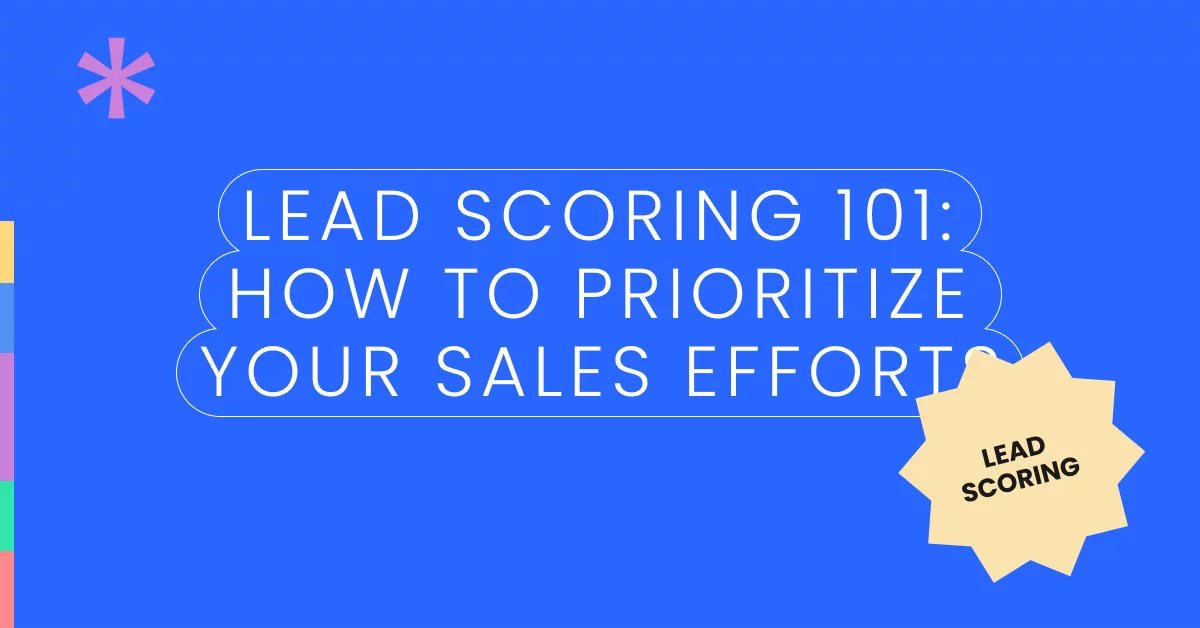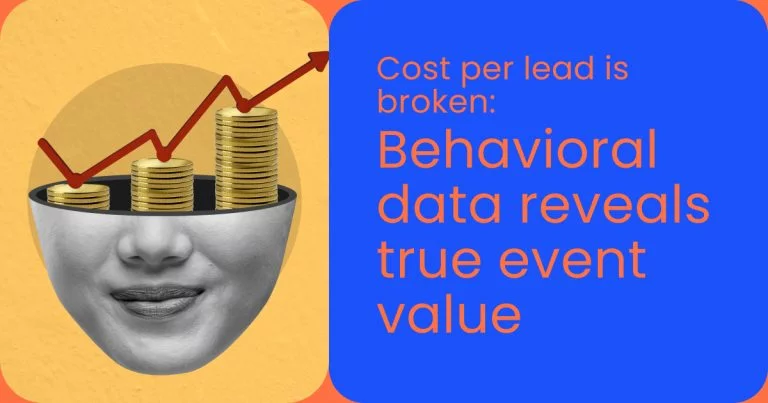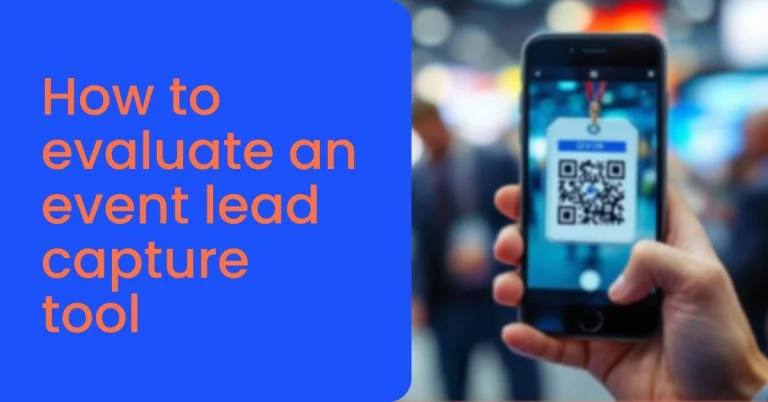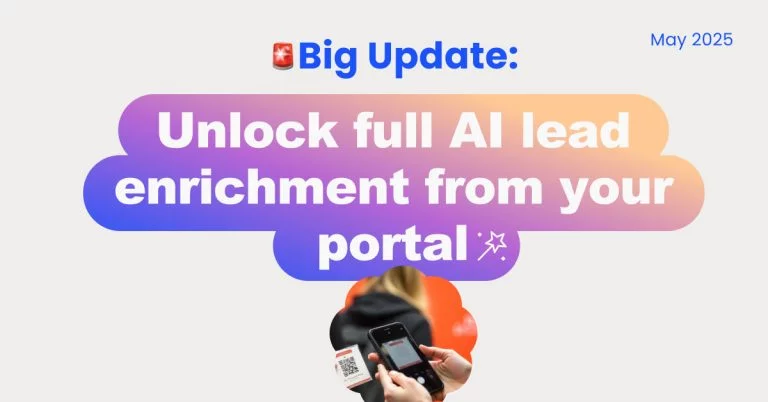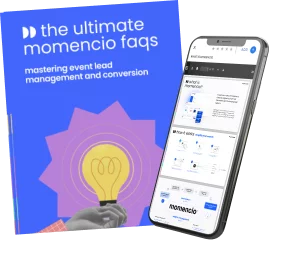In this digital world, businesses are trying to leverage advanced tools and techniques to maximize their sales efforts. One such technique is lead scoring, which helps you identify your most promising leads. You can employ this information to tailor your marketing strategies to meet the needs of high-scoring leads.
Additionally, if your sales team knows how to prioritize high-potential leads, they can save their time on dead-end prospects. This saved time can be invested in other business tasks to optimize sales and generate more leads.
Around 40% of salespeople have benefitted from lead scoring. In this write-up, we’ll discuss lead scoring and how to implement it for maximum benefit. Let’s discuss everything in detail!
TL;DR: Lead scoring helps prioritize sales efforts by assigning value to leads based on their engagement and potential to convert. Learn how to implement effective lead scoring models to focus on high-quality prospects and improve overall sales performance.
What is lead scoring 101?
Lead scoring is a technique used in sales and marketing to rank potential leads based on their likelihood of converting into paying customers. It is a process in which you assign a numerical value to leads based on certain factors. These factors involve demographics, behaviors, interactions with marketing materials, and engagement with your company’s products.
Consider some lead scoring examples. A lead who visits a website multiple times, downloads a whitepaper, and interacts with email campaigns receives a high lead score. In contrast, a lead who only sees the website once and engages a little with your website content may get a low lead score. You can perform lead scoring manually or use automation tools such as CRM. Research says 84% of companies consider CRM the most beneficial automation tool for obtaining qualified leads.
How to score lead points?
Lead scoring is not a one-step process; instead, it involves multiple layers that are discussed below:
1. Create a buyer persona
The first step in lead scoring is creating a buyer persona, which is a semi-fictional representation of your ideal customer. A buyer persona can be made of quantitative research, observation, and customer data analysis. It can include interests, preferences, pain points, and customer buying behavior. Creating a buyer persona assists you in understanding your target audience better. So, you can align your lead scoring criteria with the characteristics of your ideal customers.
2. Determine lead criteria
Once you clearly understand your buyer persona, you must determine the criteria you need to score leads. These criteria should align with the characteristics of your ideal customer and should be based on relevant data. This data can include lead source, demographic information, engagement level, and behavior. Although the lead criteria can vary depending on your business, the common ones are:
- Demographics: This includes basic information about the lead, such as their job title, company size, & location.
- Behavior: This includes the lead’s actions that indicate buying intent. For instance, website visits, signing up for a free trial, or adding items to a shopping cart, etc.
3. Assign weightage or point values
Giving a lead score aims to identify high-scoring leads that can help you close a deal. This means not all leads can get the same weightage or value. You should assign points based on lead importance and the chances of its conversion. Remember, the weightage or point value should be based on your business goals, sales objectives, and marketing strategies.
For instance, if someone subscribes to your blog updates, they aren’t very likely to become your paying customers. In contrast, if someone requests a demo and adds products to their cart, they are going to be your good paying customers. So, you should assign 5 points to blog subscribers and 20 to 30 points to your customers who request a demo to show strong buying intent.
Communicate with the sales team
They play a crucial role in lead scoring, as they are at the front lines of engaging with leads. They understand your customer’s behaviors and needs and quickly determine which lead is going to be a buying customer. Moreover, they can provide insights you may still need to include in your buying persona. So, it’s essential to involve the sales team in the lead scoring process and gather their feedback to fine-tune the scoring criteria.
Get feedback from customers
You should contact your consistent and top customers to get more details and insights into top leads. For instance, you can ask them about their early steps before purchasing from you. You can then collect data about the choices and preferences of your ideal customers that help you in lead scoring. Conduct surveys, request feedback, and carry out customer interviews to get this information.
When you get direct feedback from customers, you better understand your target audience. Hence, you can align your lead scoring criteria with their preferences, increasing the accuracy of your lead scoring model.
4. Set thresholds for each criterion
Once you have assigned weightage or point value to each criterion, the next step is to set thresholds for each criterion. Typically, thresholds are predetermined values that indicate whether a lead meets the criteria or not.
For example, if you have assigned a weightage of 10 points to a lead source criterion, you can set a threshold of “website” to indicate that leads coming from the website will receive 10 points.
Meanwhile, leads from other sources may receive fewer points or no points at all, depending upon the assigned weightage and values. Setting a threshold helps your sales team to prioritize quality leads instead of stressing over what to do next.
Although lead scoring manually may seem cost-effective, it’s time-consuming and can result in data inaccuracies. So, to eliminate these issues and streamline your lead generation and scoring, you should go for automation tools. Using sales and marketing automation tools is one of the lead-scoring best practices. These tools automate everything, making your data collection efficient and accurate! Additionally, you can use these advanced tools to do quick lead capture.
For a comprehensive look at momencio’s lead scoring capabilities, explore our detailed article on advanced lead scoring mechanisms: how momencio prioritizes and enhances lead engagement.
Benefits of lead scoring for your sales team
Lead scoring isn’t just a sales tactic—it’s a powerful strategy that can revolutionize how your business identifies and converts potential customers. By effectively implementing lead scoring, businesses can focus their efforts on high-quality leads, streamline the sales process, and improve overall revenue generation. Let’s dive into the key benefits of lead scoring and why it’s a game-changer for modern sales teams.
1. Streamlining sales efforts
One of the most significant advantages of lead scoring is its ability to streamline the sales process. Instead of wasting time chasing unqualified leads, your sales team can focus on high-priority prospects with a higher likelihood of conversion. Lead scoring provides clarity on which leads deserve immediate attention and which ones require further nurturing.
For instance, leads with a high score—those who show strong buying intent, such as requesting demos or engaging with multiple touchpoints—can be routed directly to the sales team. On the other hand, lower-scoring leads can enter a nurturing campaign until they show readiness to convert. This ensures that your team’s time and resources are allocated efficiently, maximizing productivity and results.
2. Improved marketing and sales alignment
Marketing and sales alignment has long been a challenge for businesses. Lead scoring serves as a bridge between these two departments by establishing a common understanding of what constitutes a qualified lead. When both teams agree on scoring criteria, they can work together seamlessly to attract and convert potential customers.
Marketing teams can use lead scoring to identify which prospects are sales-ready and pass them along to the sales team. Meanwhile, sales teams can provide valuable feedback on the quality of leads, helping marketers refine their campaigns to attract better prospects. This alignment reduces friction between departments and enhances overall business performance.
3. Enhanced personalization
Personalization is a key factor in driving conversions, and lead scoring helps businesses tailor their interactions based on a lead’s behavior and preferences. With insights from lead scoring, businesses can segment their audience and create customized messaging that resonates with each lead’s unique needs.
For example, a lead who frequently engages with technical whitepapers might be interested in detailed product specifications. On the other hand, a lead who watches introductory videos may prefer high-level overviews. By aligning content and communication with lead scores, businesses can deliver a personalized experience that builds trust and encourages engagement.
4. Better forecasting and decision-making
Lead scoring provides businesses with valuable data to make informed decisions. By analyzing lead scores and conversion patterns, businesses can forecast sales performance and allocate resources accordingly. This data-driven approach helps in identifying trends, evaluating campaign effectiveness, and adjusting strategies to maximize ROI.
For instance, if certain lead scoring criteria consistently result in conversions, businesses can double down on those tactics. Similarly, if certain criteria are not yielding results, they can be revised or replaced. This iterative process ensures that businesses continuously improve their lead generation and conversion strategies.
5. Higher conversion rates
Lead scoring focuses your efforts on the most promising prospects, increasing the likelihood of conversion. By targeting high-quality leads, your sales team can close deals faster and more effectively. Additionally, the insights gained from lead scoring help businesses address potential objections and pain points, further boosting conversion rates.
Businesses that use lead scoring see a 77% increase in lead generation ROI. This highlights the direct impact of lead scoring on driving revenue and achieving business goals.
6. Efficient use of resources
Every business has limited resources, and lead scoring ensures they are used wisely. By prioritizing high-value leads, businesses can focus their marketing budgets and sales efforts where they matter most. This not only reduces wasted effort but also improves the overall efficiency of your sales and marketing operations.
For example, instead of spending money on broad marketing campaigns, businesses can target specific segments with tailored campaigns that address their needs. This targeted approach is more cost-effective and delivers better results.
7. Improved customer retention
Lead scoring isn’t just about acquiring new customers—it also plays a role in customer retention. By analyzing the behavior and engagement of existing customers, businesses can identify opportunities for upselling, cross-selling, or addressing potential churn risks.
For instance, a current customer who stops engaging with your content or products may have a declining lead score, signaling the need for proactive outreach. By monitoring these signals, businesses can strengthen relationships and improve customer loyalty.
How automation enhances lead scoring
While lead scoring can be performed manually, automation takes it to the next level by eliminating human error and saving time. Automated lead scoring tools, like those integrated into CRM platforms or event solutions such as momencio, make the process seamless and scalable.
Key benefits of automation include:
- Real-time scoring: Automated tools update lead scores instantly based on a lead’s behavior, ensuring your sales team always has the latest insights.
- Accuracy: Automation reduces the risk of errors and inconsistencies, providing reliable data for decision-making.
- Scalability: As your business grows, automated tools can handle larger volumes of leads without compromising on accuracy or efficiency.
- Integration: Many automated tools integrate with your existing CRM and marketing platforms, creating a unified system for managing leads.
For example, momencio’s advanced lead scoring capabilities allow businesses to track engagement at events, assign scores based on attendee interactions, and automatically sync data with their CRM. This not only simplifies the lead scoring process but also ensures that sales teams can act quickly on high-priority leads.
10 steps to automate your lead scoring system
Automating your lead scoring system is a game-changer for businesses looking to optimize their sales and marketing processes. By using AI-driven analytics and real-time insights, companies can efficiently prioritize high-quality leads and maximize conversion rates.
Step 1: Define your Ideal Customer Profile (ICP)
Before automating lead scoring, you need a clear understanding of your ideal customer. Identify key characteristics such as:
- Industry
- Company size
- Job title
- Pain points
- Behavioral triggers
Use historical data and customer insights to refine your ICP, ensuring that your scoring model targets the most valuable leads.
Step 2: Identify key lead attributes
Determine the data points that indicate a lead’s likelihood to convert. These can be divided into:
- Demographic data (e.g., company size, location, revenue)
- Firmographic data (e.g., industry type, annual revenue)
- Behavioral data (e.g., website visits, email engagement, event participation)
Each of these attributes will contribute to your lead scoring criteria.
Step 3: Assign point values to different actions
Develop a weighted scoring model by assigning different values to lead attributes and actions. For example:
- Downloading an eBook → +10 points
- Opening an email → +5 points
- Attending a webinar → +20 points
- Requesting a demo → +50 points
Adjust the values based on historical conversion data to prioritize high-intent leads.
Step 4: Implement a CRM and marketing automation platform
To automate lead scoring, integrate a Customer Relationship Management (CRM) system like Salesforce or HubSpot with a marketing automation platform like Marketo. These tools collect and analyze data in real time, updating scores dynamically.
Step 5: Use AI and machine learning for predictive scoring
Modern AI-driven tools can analyze vast amounts of customer data to predict which leads are most likely to convert. Predictive lead scoring considers multiple factors, such as:
- Past purchasing behavior
- Interaction with marketing content
- Social media engagement
- Sales team feedback
By leveraging AI, businesses can fine-tune lead prioritization for maximum efficiency.
Step 6: Establish lead qualification tiers
Segment your leads into different categories based on their scores:
- Marketing Qualified Leads (MQLs): Leads showing interest but not yet ready for sales
- Sales Qualified Leads (SQLs): High-potential leads ready for direct engagement
- Cold leads: Leads that require further nurturing
This segmentation ensures that sales and marketing teams focus their efforts efficiently.
Step 7: Automate lead nurturing workflows
For leads that don’t immediately convert, automated nurturing workflows keep them engaged. Use:
- Personalized email sequences
- Retargeting ads
- Content recommendations
- Follow-up reminders for sales teams
By continuously nurturing leads, you increase their likelihood of moving through the funnel.
Step 8: Set up real-time alerts for high-intent leads
Configure your CRM to notify sales reps when a lead reaches a certain score threshold. Example triggers include:
- A lead viewing pricing pages multiple times
- A lead attending multiple webinars
- A lead responding to an email with a direct question about pricing
Real-time alerts allow sales teams to engage at the most opportune moments.
Step 9: Continuously optimize and refine your scoring model
Lead behavior and market dynamics change over time. Regularly review your lead scoring criteria by:
- Analyzing conversion rates for high-scoring leads
- Gathering feedback from sales teams on lead quality
- Testing different scoring weights based on new data
By refining your model, you ensure that your automation system stays effective and relevant.
Step 10: Align sales and marketing for seamless handoff
Automation alone isn’t enough—sales and marketing must work together. Regular alignment meetings should:
- Define clear handoff criteria for MQLs to become SQLs
- Ensure sales teams follow up on high-scoring leads promptly
- Adjust scoring criteria based on lead performance feedback
Conclusion
Lead scoring may seem like a challenging task, but it’s not. Especially if you are aware of lead scoring models and their best practices, you can quickly implement them to get high-quality leads. However, performing all these tasks manually can be stressful.
Lead scoring is more than just a ranking system—it’s a strategic approach that helps businesses optimize their sales efforts, improve customer experiences, and drive sustainable growth. By understanding the benefits of lead scoring and implementing it effectively, businesses can unlock new opportunities and stay ahead in a competitive market.
Whether you’re just starting with lead scoring or looking to enhance your existing strategy, tools like momencio can make the process easier and more effective. With features designed to streamline lead management and engagement, momencio helps you focus on what matters most—building meaningful connections and driving conversions.

FAQs
- What is lead scoring, and why is it important?
- Lead scoring is the process of ranking potential leads based on their likelihood of converting into customers. It helps businesses prioritize high-quality leads, ensuring that sales teams focus their efforts on prospects with the greatest potential. This improves efficiency, boosts conversion rates, and maximizes ROI.
- How do I determine the right criteria for scoring leads?
- The criteria for lead scoring depend on your target audience and business goals. Common factors include demographics (e.g., job title, company size), behavior (e.g., website visits, content downloads), and engagement with your marketing campaigns. Start by creating a buyer persona and collaborating with your sales team to align scoring criteria with your ideal customer profile.
- Can lead scoring be automated?
- Yes, lead scoring can be automated using tools like CRM systems or platforms like momencio. Automated lead scoring tools track and analyze lead behavior in real-time, assign scores based on predefined criteria, and integrate with your sales and marketing systems. This ensures accuracy, saves time, and allows you to scale your lead scoring efforts as your business grows.
- How does lead scoring improve sales and marketing alignment?
- Lead scoring creates a shared understanding between sales and marketing teams about what constitutes a qualified lead. By defining scoring criteria together, both teams can collaborate effectively to attract, nurture, and convert leads. This alignment reduces friction, improves lead quality, and ensures that marketing efforts translate into sales success.
- How can momencio help with lead scoring at events?
- momencio simplifies lead scoring by capturing attendee interactions in real-time during trade shows and events. It assigns scores based on engagement, such as badge scans, content views, or demo requests, and syncs this data directly with your CRM. This allows sales teams to prioritize leads instantly and tailor follow-ups based on attendee interests and behavior.
